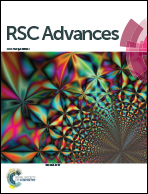Microwave absorption enhancement by adjusting reactant ratios and filler contents based on 1D K–MnO2@PDA and poly(vinylidene fluoride) matrix†
Abstract
One-dimensional K–MnO2 nanorods were prepared by a wet chemical process. Dopamine hydrochloride (PDA) layers with various thicknesses were coated and finally, the composites were filled in a poly(vinylidene fluoride) (PVDF) matrix using the hot-molding procedure. The complex permittivity and permeability of the K–MnO2@PDA/PVDF composites could be adjusted by reactant amount ratios and filler contents. The minimum reflection loss could reach −49.4 dB and an effective absorption bandwidth (<−10 dB) covering 11.12 GHz was achieved with 20% filler content when the reactant amount ratio between K–MnO2 and PDA was 4 : 0.375, which was derived from effective internal polarization processes. It is expected that these novel composites can be used as high-performance microwave absorbers.



 Please wait while we load your content...
Please wait while we load your content...